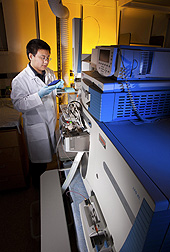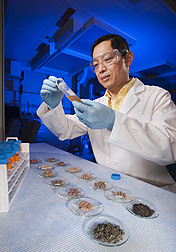Digital Detectives Decipher Ingredients
Television shows featuring crime scene investigators have been keeping viewers intrigued for years. But the Agricultural Research Service’s intriguing “food composition investigators” are just as innovative at deciphering truth from fiction relating to ingredients of plant-based foods and dietary supplements. The researchers are at the ARS Food Composition and Methods Development Laboratory, which is headed by research leader James Harnly. The laboratory is part of the Beltsville [Maryland] Human Nutrition Research Center (BHNRC).
They’re using new equipment and a metabolomics approach to discover compounds and to accurately identify ingredients in foods and supplements. They are also looking at chemical composition patterns to find differences between cultivars, growing years, and locations—knowledge important for consumers, farmers, and marketers.
Metabolomics is the analysis of all the intermediate and end products, or metabolites, of cell processes. These individual molecules are produced by active, living cells during the metabolic process. Lipids, fats, sugars, amino acids, and flavonoids, for example, are all metabolites. The plant metabolome furnishes nutrients necessary for human health.
Metabolomics requires bioinformatics tools for data analysis, visualization, and integration. The researchers are using newly procured equipment—high-resolution mass spectrometers (HRMS)—to conduct metabolomic studies. “High resolution” means the technology gives a high level of information. For example, with HRMS, glucose has a measured mass of 179.0556 atomic mass units (amu), compared with 179 amu as detected by a regular mass spectrometer. HRMS has the potential for identifying every metabolite in a sample.
Green Tea: Sip it or Supp it?
The U.S. Food and Drug Administration issued “current good manufacturing practices” that require all botanical ingredients in supplements to be identified. To answer the increased demands for valid analytical methods, Harnly chaired an expert review panel that established “Guidelines for Validation of Botanical Identification Methods” for AOAC International (Association of Analytical Communities)—a nonprofit association dedicated to excellence in analytical methods.
|
|
Pei Chen, a chemist with the ARS food-composition lab, headed a study of the differences between phytochemicals in green tea supplements and green tea leaves used for brewing beverages. Green tea-based dietary supplements have gained popularity in the U.S. market in recent years. But when it comes to sipping green tea versus taking the dietary supplement form, the jury is out as to the better choice relative to health. HRMS can be very useful in identifying the differences.
Chen and BHNRC colleagues Jianghao Sun and Long-Ze Lin analyzed “extractions” of 20 commercially available green tea dietary supplement products (12 tablets or capsules and 8 liquid samples) and 8 dry green tea leaf samples, and they compared the chemical constituents of the samples using an analytical technique called “HPLC/MS.”
Brand names were not disclosed in the published study, but the researchers noted that most major dietary supplement manufacturers were represented.
The study demonstrated that flavonol glycosides were degraded and the compound catechin had oxidized during manufacturing and storage for many of the green tea supplement samples studied. They also found some additives in the supplements that were not listed on the labels.
The BHNRC team found a significant chemical variance across the range of green tea dietary supplements they sampled. They also noted that the daily intake amount recommended by the labels varied significantly. They concluded that although there are some good green tea dietary supplement products, there is no way for the consumer to know the quality from reading the labels. More importantly, the consumer may ingest other botanical extracts unintentionally, and the quality of those green tea products varies significantly. The claim that a green tea dietary supplement is a good alternative to tea leaves is questionable from a chemical-composition point of view, and the results “demonstrate the urgency of quality control for green tea dietary supplement products,” wrote the authors. The 2011 study was published in the Journal of AOAC International.
|
|
Organic and Traditional Differences
Switching to fresh fruit, the BHNRC “Rio Red Grapefruit” study showed that MS fingerprinting, when combined with a pattern-recognition method called “ANOVA-PCA,” could clearly establish that there are chemical differences between grapefruit samples in terms of growing year, harvest time, and farming method (conventional or organic).
For the study, Harnly and Chen studied samples of Rio Red grapefruit furnished by Gene Lester of the ARS Food Quality Laboratory, also in Beltsville. The grapefruits were grown using conventional and organic cultivation methods. They were harvested at three growing phases (early, mid, and late season) during 2005 and 2006. The juices were analyzed by mass spectrometry with no separation of the molecules. The overlapping mass spectra of all the molecules, or the “spectrometric fingerprint,” is very complex and, like human fingerprints, is analyzed by looking at the overall pattern.
ANOVA-PCA was used to determine whether a distinction could be made between the two cultivation methods and the three harvest dates (growing phases) by analyzing the MS spectral fingerprints of the grapefruit juices. The analysis showed that the chemical patterns of the fingerprints were statistically different among the farming modes, growing years, and times of harvest, regardless of the MS method used.
The results are important in demonstrating that conventional and organic products have different chemical compositions, although it is unknown at this time if these differences have significance to consumers. The 2010 study was published in the Journal of Agricultural and Food Chemistry.
Let’s Not Forget Herbals
American ginseng is one of the most commonly used herbal medicines in the world. But discriminating between ginsengs grown in different countries is difficult using traditional methods.
Chen headed a study involving MS fingerprints and pattern-recognition analysis methods to discriminate between American ginseng grown in the United States and that grown in China. They studied 15 American ginseng samples grown in Wisconsin and 25 samples grown in China. The MS fingerprints, representing the chemical compositions of the samples, made it possible to distinguish between samples grown in the two different locations. The 2011 study was published in Analytical and Bioanalytical Chemistry.—By Rosalie Marion Bliss, Agricultural Research Service Information Staff.
This research is part of Human Nutrition, an ARS national program (#107) described at www.nps.ars.usda.gov.
James Harnly and Pei Chen are with the USDA-ARS Food Composition and Methods Development Laboratory, 10300 Baltimore Ave., Beltsville, MD 20705-2350; (301) 504-8569, ext. 261 [Harnly], (301) 504-8144, ext. 238 [Chen].
"Digital Detectives Decipher Ingredients" was published in the April 2012 issue of Agricultural Research magazine.









